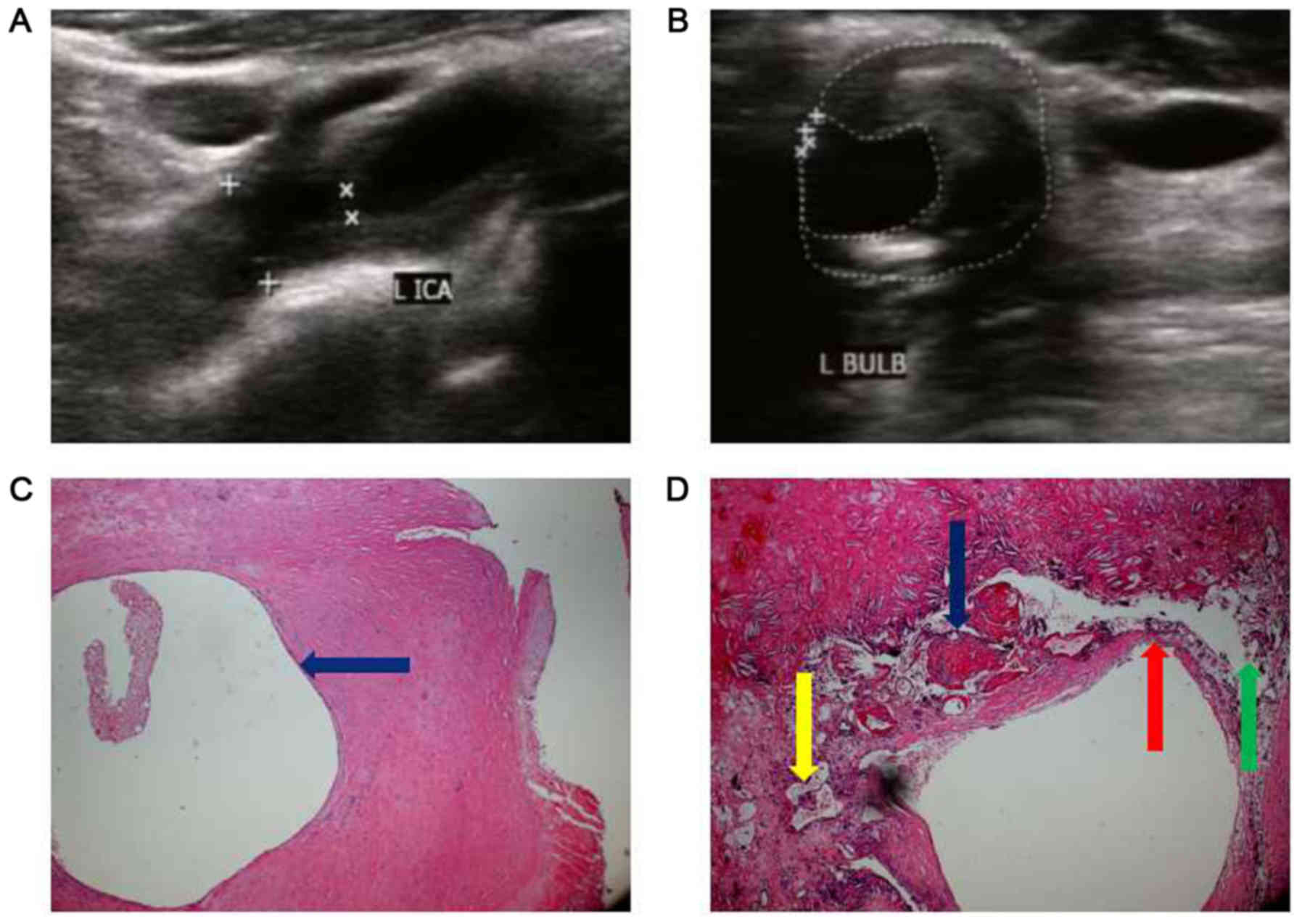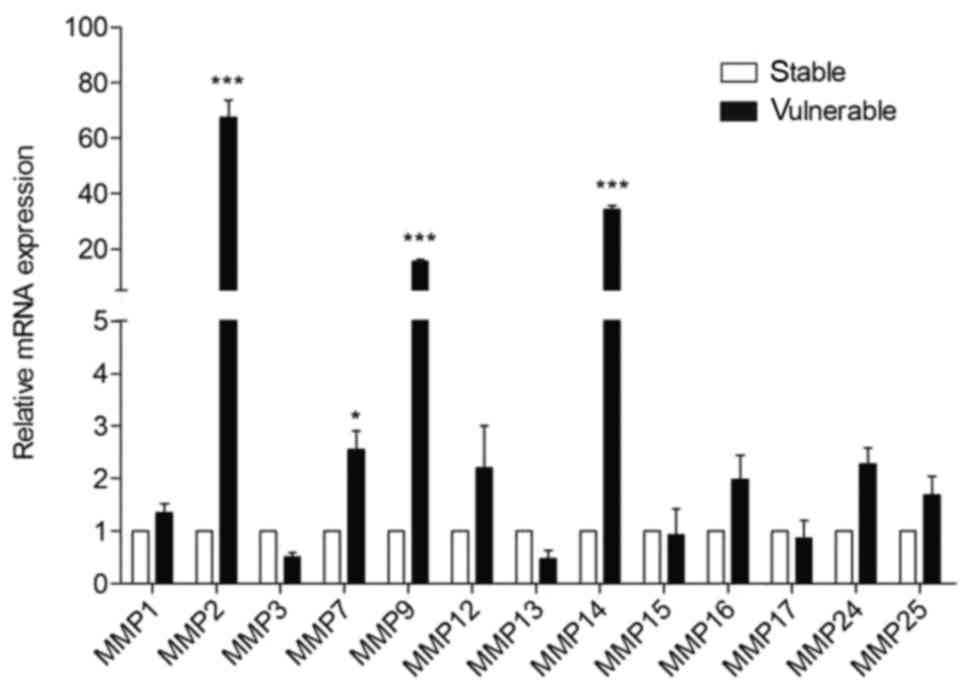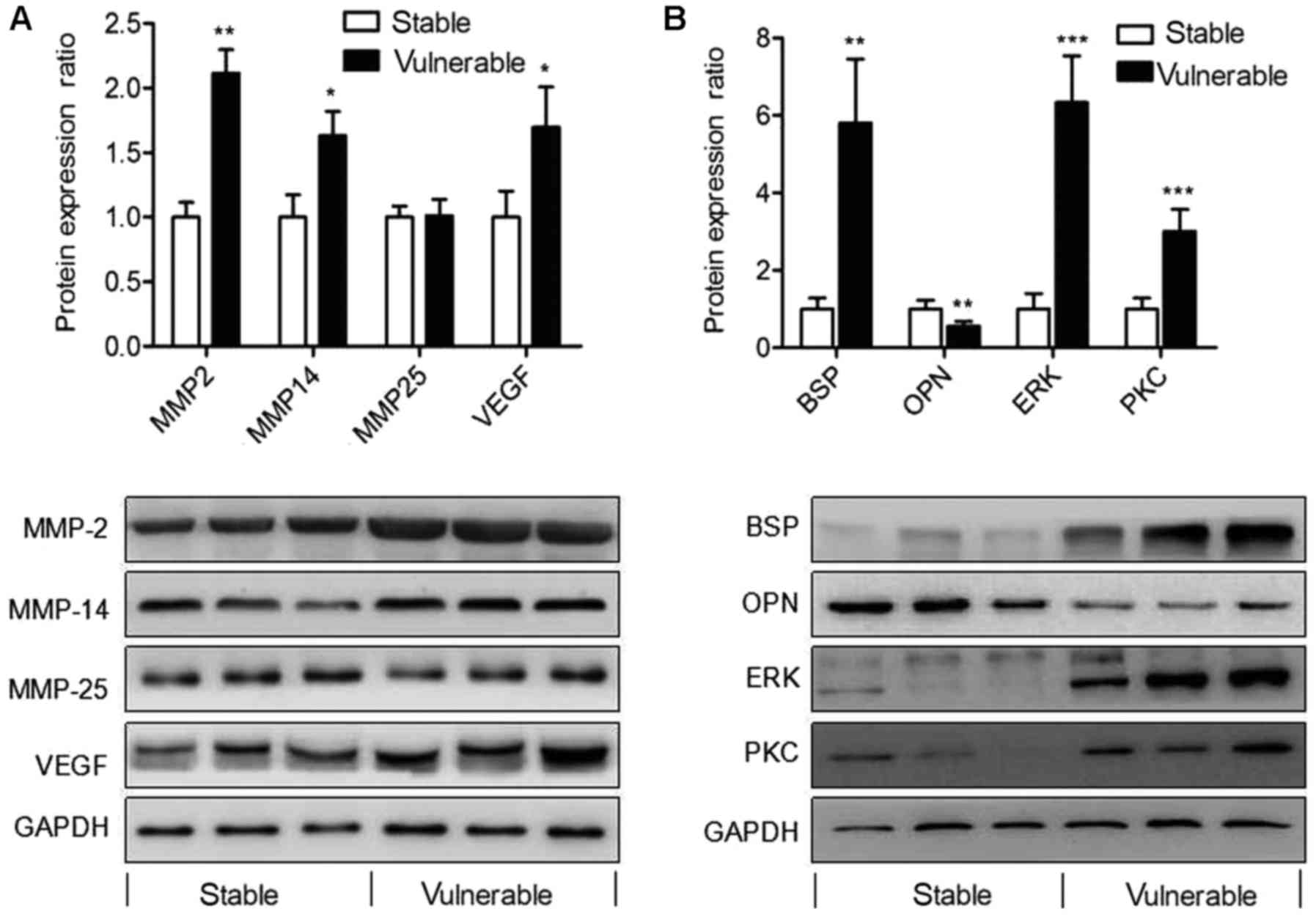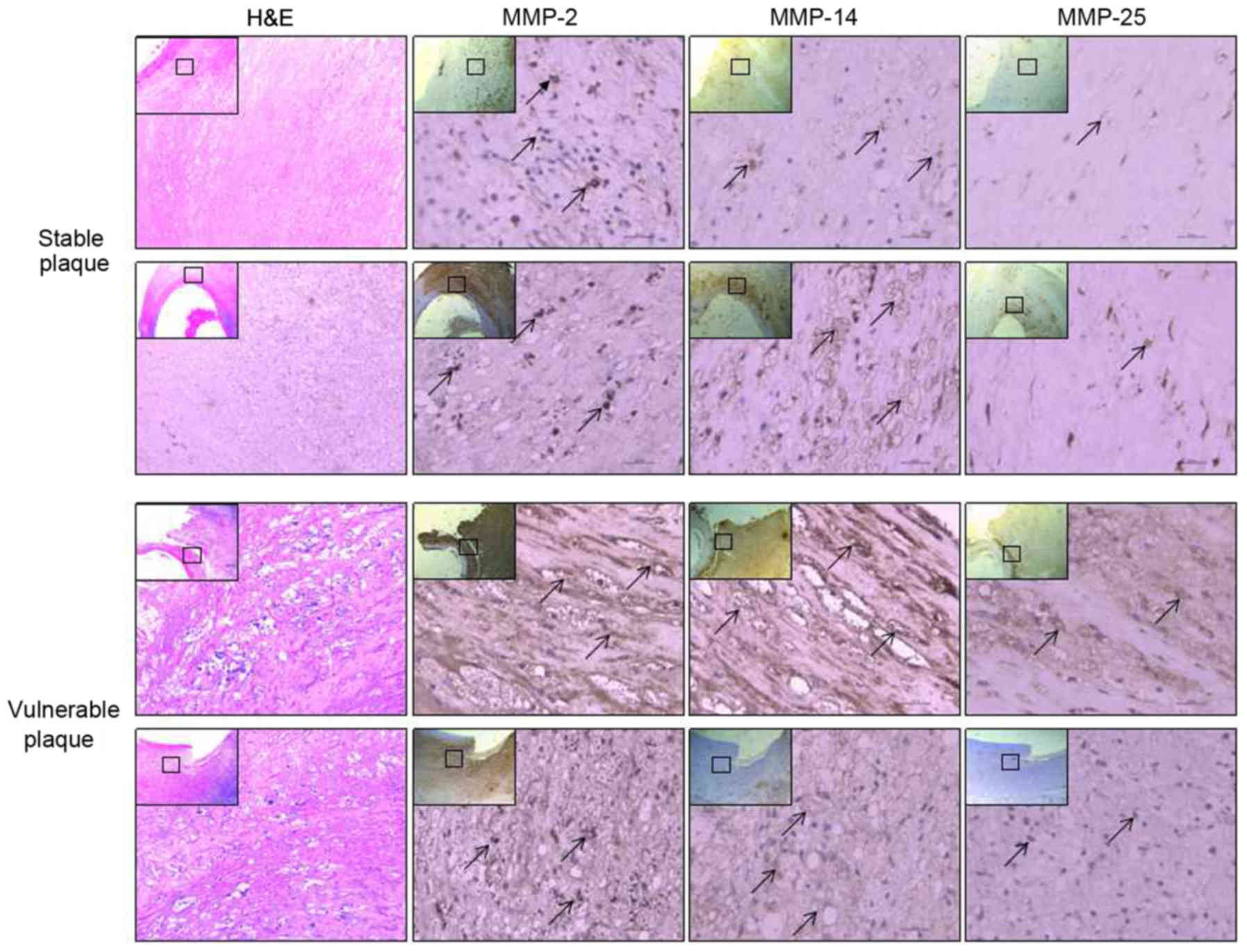|
1
|
Liu XS, Zhao HL, Cao Y, Lu Q and Xu JR:
Comparison of carotid atherosclerotic plaque characteristics by
high-resolution black-blood MR imaging between patients with
first-time and recurrent acute ischemic stroke. AJNR Am J
Neuroradiol. 33:1257–1261. 2012. View Article : Google Scholar : PubMed/NCBI
|
|
2
|
Rosamond W, Flegal K, Friday G, Furie K,
Go A, Greenlund K, Haase N, Ho M, Howard V, Kissela B, et al: Heart
disease and stroke statistics-2007 update: A report from the
American Heart Association Statistics Committee and Stroke
Statistics Subcommittee. Circulation. 115:e69–e171. 2007.
View Article : Google Scholar : PubMed/NCBI
|
|
3
|
Kuk M, Wannarong T, Beletsky V, Parraga G,
Fenster A and Spence JD: Volume of carotid artery ulceration as a
predictor of cardiovascular events. Stroke. 45:1437–1441. 2014.
View Article : Google Scholar : PubMed/NCBI
|
|
4
|
Jin G: The relationship between serum
CXCL16 level and carotid vulnerable plaque in patients with
ischemic stroke. Eur Rev Med Pharmacol Sci. 21:3911–3915.
2017.PubMed/NCBI
|
|
5
|
Chatzizisis YS, Antoniadis AP, Wentzel JJ
and Giannoglou GD: Vulnerable plaque: The biomechanics of matter.
Atherosclerosis. 236:351–352. 2014. View Article : Google Scholar : PubMed/NCBI
|
|
6
|
Badimon L and Vilahur G: Thrombosis
formation on atherosclerotic lesions and plaque rupture. J Intern
Med. 276:618–632. 2014. View Article : Google Scholar : PubMed/NCBI
|
|
7
|
Yonetsu T and Jang IK: Advances in
Intravascular Imaging: New insights into the vulnerable plaque from
imaging studies. Korean Circ J. 48:1–15. 2018. View Article : Google Scholar : PubMed/NCBI
|
|
8
|
Virmani R, Burke AP, Farb A and Kolodgie
FD: Pathology of the vulnerable plaque. J Am Coll Cardiol. 47 8
Suppl:C13–C18. 2006. View Article : Google Scholar : PubMed/NCBI
|
|
9
|
Souilhol C, Harmsen MC, Evans PC and
Krenning G: Endothelial-mesenchymal transition in atherosclerosis.
Cardiovasc Res. 114:565–577. 2018. View Article : Google Scholar : PubMed/NCBI
|
|
10
|
Heeneman S, Cleutjens JP, Faber BC,
Creemers EE, van Suylen RJ, Lutgens E, Cleutjens KB and Daemen MJ:
The dynamic extracellular matrix: Intervention strategies during
heart failure and atherosclerosis. J Pathol. 200:516–525. 2003.
View Article : Google Scholar : PubMed/NCBI
|
|
11
|
Galis ZS, Sukhova GK, Lark MW and Libby P:
Increased expression of matrix metalloproteinases and matrix
degrading activity in vulnerable regions of human atherosclerotic
plaques. J Clin Invest. 94:2493–2503. 1994. View Article : Google Scholar : PubMed/NCBI
|
|
12
|
Jones CB, Sane DC and Herrington DM:
Matrix metalloproteinases: A review of their structure and role in
acute coronary syndrome. Cardiovasc Res. 59:812–823. 2003.
View Article : Google Scholar : PubMed/NCBI
|
|
13
|
Singh T, Adekoya OA and Jayaram B:
Understanding the binding of inhibitors of matrix
metalloproteinases by molecular docking, quantum mechanical
calculations, molecular dynamics simulations, and a MMGBSA/MMBappl
study. Mol Biosyst. 11:1041–1051. 2015. View Article : Google Scholar : PubMed/NCBI
|
|
14
|
Nagase H and Woessner JF Jr: Matrix
metalloproteinases. J Biol Chem. 274:21491–21494. 1999. View Article : Google Scholar : PubMed/NCBI
|
|
15
|
Graham CA, Chan RW, Chan DY, Chan CP, Wong
LK and Rainer TH: Matrix metalloproteinase 9 mRNA: An early
prognostic marker for patients with acute stroke. Clin Biochem.
45:352–355. 2012. View Article : Google Scholar : PubMed/NCBI
|
|
16
|
Heo W, Lee YS, Son CH, Yang K, Park YS and
Bae J: Radiation-induced matrix metalloproteinases limit natural
killer cell-mediated anticancer immunity in NCI-H23 lung cancer
cells. Mol Med Rep. 11:1800–1806. 2015. View Article : Google Scholar : PubMed/NCBI
|
|
17
|
Han Y, Mao X, Wang L, Liu J, Wang D, Cheng
H and Miao G: increased levels of soluble cluster of
differentiation 40 ligand, matrix metalloproteinase 9, and matrix
metalloproteinase 2 are associated with carotid plaque
vulnerability in patients with ischemic cerebrovascular disease.
World Neurosurg. 105:709–713. 2017. View Article : Google Scholar : PubMed/NCBI
|
|
18
|
Virmani R, Kolodgie FD, Burke AP, Finn AV,
Gold HK, Tulenko TN, Wrenn SP and Narula J: Atherosclerotic plaque
progression and vulnerability to rupture: Angiogenesis as a source
of intraplaque hemorrhage. Arterioscler Thromb Vasc Biol.
25:2054–2061. 2005. View Article : Google Scholar : PubMed/NCBI
|
|
19
|
Foley CJ, Fanjul-Fernández M, Bohm A,
Nguyen N, Agarwal A, Austin K, Koukos G, Covic L, López-Otín C and
Kuliopulos A: Matrix metalloprotease 1a deficiency suppresses tumor
growth and angiogenesis. Oncogene. 33:2264–2272. 2014. View Article : Google Scholar : PubMed/NCBI
|
|
20
|
Doherty TM, Asotra K, Fitzpatrick LA, Qiao
JH, Wilkin DJ, Detrano RC, Dunstan CR, Shah PK and Rajavashisth TB:
Calcification in atherosclerosis: Bone biology and chronic
inflammation at the arterial crossroads. Proc Natl Acad Sci USA.
100:11201–11206. 2003. View Article : Google Scholar : PubMed/NCBI
|
|
21
|
Wahlgren CM, Zheng W, Shaalan W, Tang J
and Bassiouny HS: Human carotid plaque calcification and
vulnerability. Relationship between degree of plaque calcification,
fibrous cap inflammatory gene expression and symptomatology.
Cerebrovasc Dis. 27:193–200. 2009. View Article : Google Scholar : PubMed/NCBI
|
|
22
|
Charo IF and Ransohoff RM: The many roles
of chemokines and chemokine receptors in inflammation. N Engl J
Med. 354:610–621. 2006. View Article : Google Scholar : PubMed/NCBI
|
|
23
|
Charo IF and Taubman MB: Chemokines in the
pathogenesis of vascular disease. Circ Res. 95:858–866. 2004.
View Article : Google Scholar : PubMed/NCBI
|
|
24
|
Kruger TE, Miller AH, Godwin AK and Wang
J: Bone sialoprotein and osteopontin in bone metastasis of
osteotropic cancers. Crit Rev Oncol Hematol. 89:330–341. 2014.
View Article : Google Scholar : PubMed/NCBI
|
|
25
|
Naghavi M, Libby P, Falk E, Casscells SW,
Litovsky S, Rumberger J, Badimon JJ, Stefanadis C, Moreno P,
Pasterkamp G, et al: From vulnerable plaque to vulnerable patient:
A call for new definitions and risk assessment strategies: Part I.
Circulation. 108:1664–1672. 2003. View Article : Google Scholar : PubMed/NCBI
|
|
26
|
Livak KJ and Schmittgen TD: Analysis of
relative gene expression data using real-time quantitative PCR and
the 2(-Delta Delta C(T)) method. Methods. 25:402–408. 2001.
View Article : Google Scholar : PubMed/NCBI
|
|
27
|
Müller A, Krämer SD, Meletta R, Beck K,
Selivanova SV, Rancic Z, Kaufmann PA, Vos B, Meding J, Stellfeld T,
et al: Gene expression levels of matrix metalloproteinases in human
atherosclerotic plaques and evaluation of radiolabeled inhibitors
as imaging agents for plaque vulnerability. Nucl Med Biol.
41:562–569. 2014. View Article : Google Scholar : PubMed/NCBI
|
|
28
|
Hakimzadeh N, Pinas VA, Molenaar G, de
Waard V, Lutgens E, van Eck-Smit BLF, de Bruin K, Piek JJ, Eersels
JLH, Booij J, et al: Novel molecular imaging ligands targeting
matrix metalloproteinases 2 and 9 for imaging of unstable
atherosclerotic plaques. PLoS One. 12:e01877672017. View Article : Google Scholar : PubMed/NCBI
|
|
29
|
Razuvaev A, Ekstrand J, Folkersen L,
Agardh H, Markus D, Swedenborg J, Hansson GK, Gabrielsen A,
Paulsson-Berne G, Roy J and Hedin U: Correlations between clinical
variables and gene-expression profiles in carotid plaque
instability. Eur J Vasc Endovasc Surg. 42:722–730. 2011. View Article : Google Scholar : PubMed/NCBI
|
|
30
|
Ragino IuI, Cherniavskiĭ AM, Polonskaia
IaV, Volkov AM, Semaeva EV, Tsymbal SIu and Voevoda MI: Changes in
proinflammatory cytokine and destructive metalloproteinase levels
during formation of unstable atherosclerotic plaque. Kardiologiia.
49:43–49. 2009.(In Russian). PubMed/NCBI
|
|
31
|
Andrews JPM, Fayad ZA and Dweck MR: New
methods to image unstable atherosclerotic plaques. Atherosclerosis.
272:118–128. 2018. View Article : Google Scholar : PubMed/NCBI
|
|
32
|
Lapenna D, Ciofani G, Pierdomenico SD,
Giamberardino MA, Ucchino S and Davì G: Association of serum
bilirubin with oxidant damage of human atherosclerotic plaques and
the severity of atherosclerosis. Clin Exp Med. 18:119–124. 2018.
View Article : Google Scholar : PubMed/NCBI
|
|
33
|
Pelisek J, Eckstein HH and Zernecke A:
Pathophysiological mechanisms of carotid plaque vulnerability:
Impact on ischemic stroke. Arch Immunol Ther Exp (Warsz).
60:431–442. 2012. View Article : Google Scholar : PubMed/NCBI
|
|
34
|
Sakakura K, Nakano M, Otsuka F, Ladich E,
Kolodgie FD and Virmani R: Pathophysiology of atherosclerosis
plaque progression. Heart Lung Circ. 22:399–411. 2013. View Article : Google Scholar : PubMed/NCBI
|
|
35
|
Rai V and Agrawal DK: The role of damage-
and pathogen-associated molecular patterns in inflammation-mediated
vulnerability of atherosclerotic plaques. Can J Physiol Pharmacol.
95:1245–1253. 2017. View Article : Google Scholar : PubMed/NCBI
|
|
36
|
Jain M, Wu B, Pisapia D, Salvatore S,
Mukherjee S and Narula N: A component-by-component characterisation
of high-risk atherosclerotic plaques by multiphoton microscopic
imaging. J Microsc. 268:39–44. 2017. View Article : Google Scholar : PubMed/NCBI
|
|
37
|
Ulrich V, Rotllan N, Araldi E, Luciano A,
Skroblin P, Abonnenc M, Perrotta P, Yin X, Bauer A, Leslie KL, et
al: Chronic miR-29 antagonism promotes favorable plaque remodeling
in atherosclerotic mice. EMBO Mol Med. 8:643–653. 2016. View Article : Google Scholar : PubMed/NCBI
|
|
38
|
Eilenberg W, Stojkovic S, Kaider A,
Kozakowski N, Domenig CM, Burghuber C, Nanobachvili J, Huber K,
Klinger M, Neumayer C, et al: NGAL and MMP-9/NGAL as biomarkers of
plaque vulnerability and targets of statins in patients with
carotid atherosclerosis. Clin Chem Lab Med. 56:147–156. 2017.
View Article : Google Scholar : PubMed/NCBI
|
|
39
|
Visse R and Nagase H: Matrix
metalloproteinases and tissue inhibitors of metalloproteinases:
Structure, function, and biochemistry. Circ Res. 92:827–839. 2003.
View Article : Google Scholar : PubMed/NCBI
|
|
40
|
Prebble H, Cross S, Marks E, Healy J,
Searle E, Aamir R, Butler A, Roake J, Hock B, Anderson N and Gieseg
SP: Induced macrophage activation in live excised atherosclerotic
plaque. Immunobiology. 223:526–535. 2018. View Article : Google Scholar : PubMed/NCBI
|
|
41
|
Chen Q, Jin M, Yang F, Zhu J, Xiao Q and
Zhang L: Matrix metalloproteinases: Inflammatory regulators of cell
behaviors in vascular formation and remodeling. Mediators Inflamm.
2013:9283152013. View Article : Google Scholar : PubMed/NCBI
|
|
42
|
Ohkawara H, Ikeda K, Ogawa K and Takeishi
Y: Membrane Type 1-matrix metalloproteinase (Mt1-Mmp) identified as
a multifunctional regulator of vascular responses. Fukushima J Med
Sci. 61:91–100. 2015. View Article : Google Scholar : PubMed/NCBI
|
|
43
|
Korol RM, Canham PB, Liu L, Viswanathan K,
Ferguson GG, Hammond RR, Finlay HM, Baker HV, Lopez C and Lucas AR:
Detection of altered extracellular matrix in surface layers of
unstable carotid plaque: An optical spectroscopy, birefringence and
microarray genetic analysis. Photochem Photobiol. 87:1164–1172.
2011. View Article : Google Scholar : PubMed/NCBI
|
|
44
|
Rohwedder I, Montanez E, Beckmann K,
Bengtsson E, Dunér P, Nilsson J, Soehnlein O and Fässler R: Plasma
fibronectin deficiency impedes atherosclerosis progression and
fibrous cap formation. EMBO Mol Med. 4:564–576. 2012. View Article : Google Scholar : PubMed/NCBI
|
|
45
|
Newby AC: Metalloproteinases promote
plaque rupture and myocardial infarction: A persuasive concept
waiting for clinical translation. Matrix Biol. 44–46:157–166. 2015.
View Article : Google Scholar
|
|
46
|
Starr AE, Bellac CL, Dufour A, Goebeler V
and Overall CM: Biochemical characterization and N-terminomics
analysis of leukolysin, the membrane-type 6 matrix metalloprotease
(MMP25): Chemokine and vimentin cleavages enhance cell migration
and macrophage phagocytic activities. J Biol Chem. 287:13382–13395.
2012. View Article : Google Scholar : PubMed/NCBI
|
|
47
|
Michel JB, Martin-Ventura JL, Nicoletti A
and Ho-Tin-Noé B: Pathology of human plaque vulnerability:
Mechanisms and consequences of intraplaque haemorrhages.
Atherosclerosis. 234:311–319. 2014. View Article : Google Scholar : PubMed/NCBI
|
|
48
|
Gopalakrishnan M, Silva-Palacios F,
Taytawat P, Pant R and Klein L: Role of inflammatory mediators in
the pathogenesis of plaque rupture. J Invasive Cardiol. 26:484–492.
2014.PubMed/NCBI
|
|
49
|
Golledge J, McCann M, Mangan S, Lam A and
Karan M: Osteoprotegerin and osteopontin are expressed at high
concentrations within symptomatic carotid atherosclerosis. Stroke.
35:1636–1641. 2004. View Article : Google Scholar : PubMed/NCBI
|
|
50
|
Farrokhi E, Samani KG and Chaleshtori MH:
Oxidized low-density lipoprotein increases bone sialoprotein
expression in vascular smooth muscle cells via runt-related
transcription factor 2. Am J Med Sci. 349:240–243. 2015. View Article : Google Scholar : PubMed/NCBI
|
|
51
|
Fedarko NS, Jain A, Karadag A and Fisher
LW: Three small integrin binding ligand N-linked glycoproteins
(SIBLINGs) bind and activate specific matrix metalloproteinases.
FASEB J. 18:734–736. 2004. View Article : Google Scholar : PubMed/NCBI
|
|
52
|
Harris NL, Rattray KR, Tye CE, Underhill
TM, Somerman MJ, D'Errico JA, Chambers AF, Hunter GK and Goldberg
HA: Functional analysis of bone sialoprotein: Identification of the
hydroxyapatite-nucleating and cell-binding domains by recombinant
peptide expression and site-directed mutagenesis. Bone. 27:795–802.
2000. View Article : Google Scholar : PubMed/NCBI
|
|
53
|
Yang Y, Cui Q and Sahai N: How does bone
sialoprotein promote the nucleation of hydroxyapatite? A molecular
dynamics study using model peptides of different conformations.
Langmuir. 26:9848–9859. 2010. View Article : Google Scholar : PubMed/NCBI
|
|
54
|
Golledge J, McCann M, Mangan S, Lam A and
Karan M: Osteoprotegerin and osteopontin are expressed at high
concentrations within symptomatic carotid atherosclerosis. Stroke.
35:1636–1641. 2004. View Article : Google Scholar : PubMed/NCBI
|
|
55
|
Higgins CL, Isbilir S, Basto P, Chen IY,
Vaduganathan M, Vaduganathan P, Reardon MJ, Lawrie G, Peterson L
and Morrisett JD: Distribution of alkaline phosphatase,
osteopontin, RANK ligand and osteoprotegerin in calcified human
carotid atheroma. Protein J. 34:315–328. 2015. View Article : Google Scholar : PubMed/NCBI
|
|
56
|
Newby AC: Proteinases and plaque rupture:
Unblocking the road to translation. Curr Opin Lipidol. 25:358–366.
2014. View Article : Google Scholar : PubMed/NCBI
|
|
57
|
Newby AC: Newby: Dual role of matrix
metalloproteinases (matrixins) in intimal thickening and
atherosclerotic plaque rupture. Physiol Rev. 85:1–31. 2005.
View Article : Google Scholar : PubMed/NCBI
|
|
58
|
Steitz SA, Speer MY, McKee MD, Liaw L,
Almeida M, Yang H and Giachelli CM: Osteopontin inhibits mineral
deposition and promotes regression of ectopic calcification. Am J
Pathol. 161:2035–2046. 2002. View Article : Google Scholar : PubMed/NCBI
|
|
59
|
Gravallese EM: Osteopontin: A bridge
between bone and the immune system. J Clin Invest. 112:147–149.
2003. View Article : Google Scholar : PubMed/NCBI
|
|
60
|
Xu ST, Zou FZ, Cai LN and Xu WL: The
downregulation of OPN inhibits proliferation and migration and
regulate activation of Erk1/2 in ECA-109 cells. Int J Clin Exp Med.
8:5361–5369. 2015.PubMed/NCBI
|


















